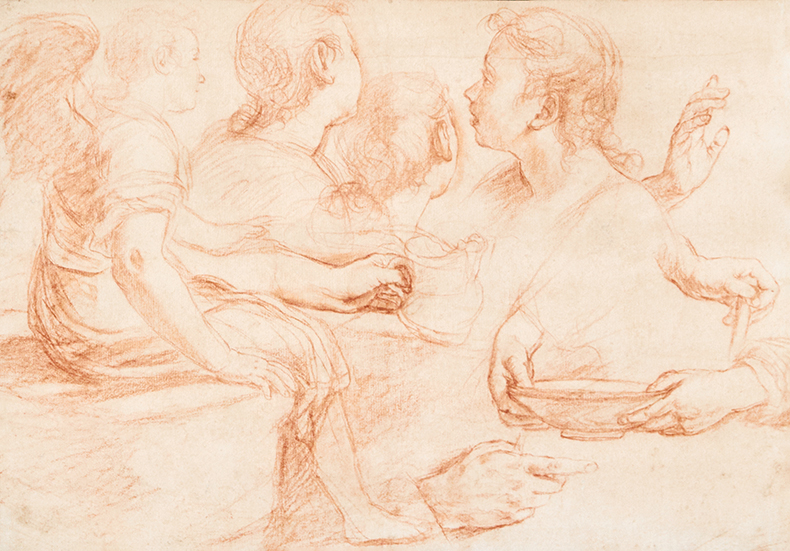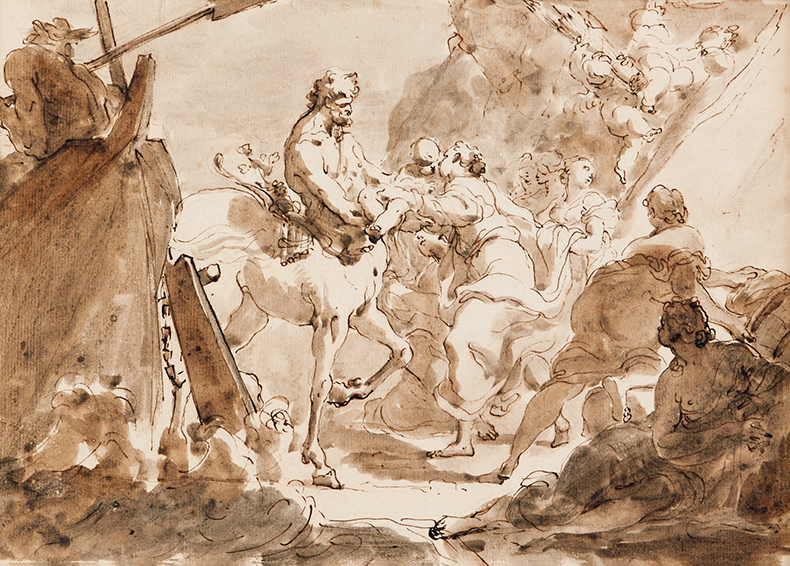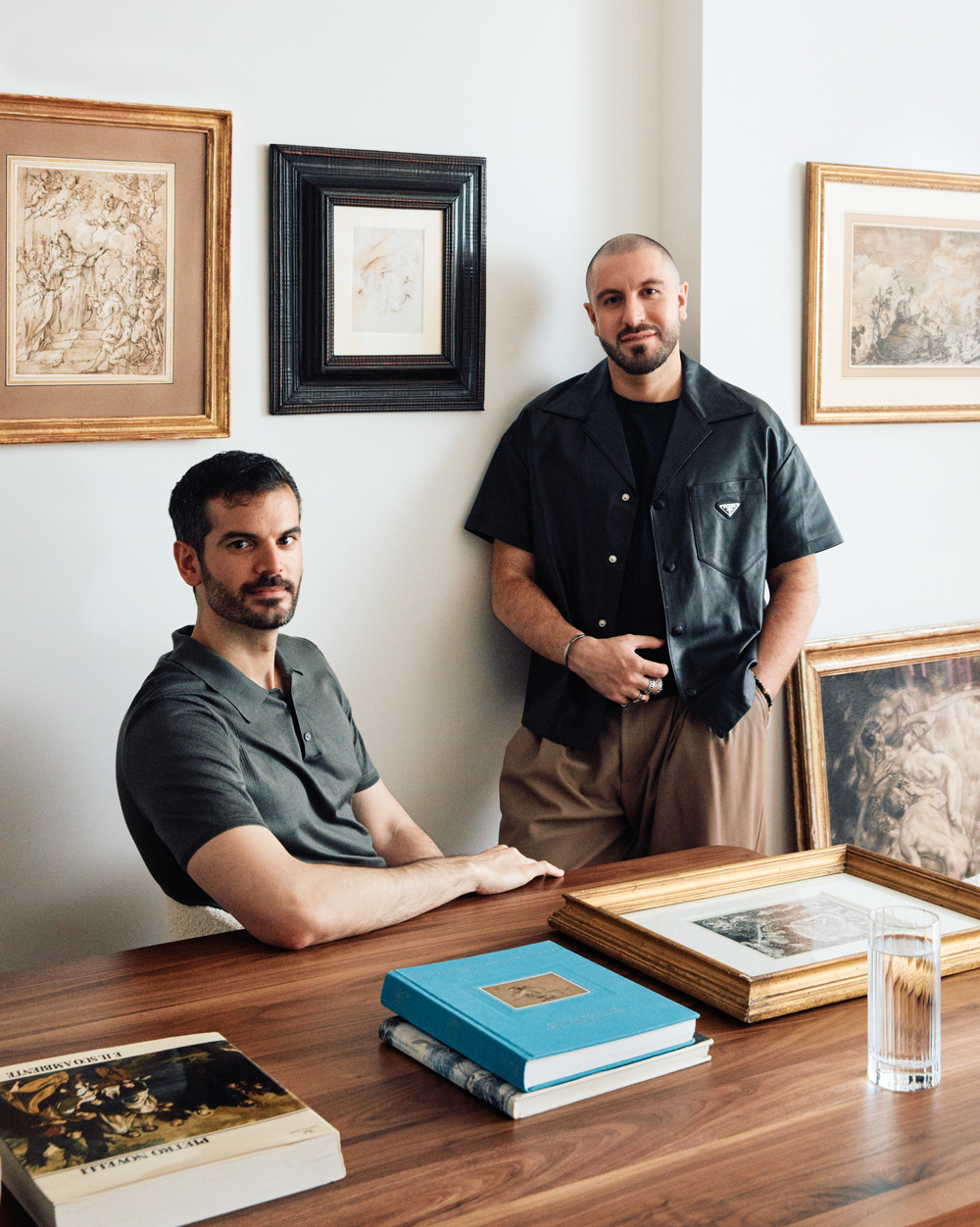From the September 2024 issue of Apollo. Preview and subscribe here.
Storms rage over cliffs and pastures alongside ancient villages, as warriors on horseback collide, sinners cower and martyred saints ascend into the embrace of angels in the Old Master drawings that hang throughout the Manhattan apartment of Domenico Lanzara and Sean Imfeld. A married couple in their late thirties, they regale me for hours with tales of European artists who competed 500 years ago for commissions from popes and noblemen while using easeful curls and slashes of ink, graphite, charcoal and chalk to convey turning points in the lives of biblical and mythological figures.
At the couple’s home in an art deco skyscraper, a summer thunderstorm pelts the windowpanes as the two men also describe their own adventures, travelling widely to scour dealer and auction house inventories, while debunking old attribution legends and agreeing on purchases. In building a collection, Imfeld says, ‘You need to find the right drawing,’ and Lanzara finishes the thought: ‘The one that calls to you.’
On the road and in the market, they have defied expectations for ‘two modern young gay men living in New York City’, Lanzara explains. They are decades younger than most of their fellow enthusiasts for Old Masters. Some dealers have assumed that the two men are museum workers – they have been asked, ‘Who do you represent?’ And they have been dismissed as much too embryonic to have amassed enough wealth or expertise to buy in this rarefied realm. ‘I don’t think you have it,’ a dealer in Rome told them, upon bringing out wares worth more than £20,000 apiece.
Above a 20th-century chest of drawers are Luca Giordano’s copy of Raphael’s Battle of Constantine against Maxentius (top centre), Francesco Solimena’s Martyrdom of Saint Bartholomew (top right), Giovanni Paggi’s Gathering around an open coffin in a church (bottom centre) and Nicola Malinconico’s Aaron and the Punishment of Korah (bottom right). Photo: Blaine Davis

Lanzara and Imfeld have turned into crusaders, spreading the word among their peers about the intellectual, aesthetic and emotional rewards of their collecting niche. They serve on the Metropolitan Museum of Art’s Visiting Committee for Drawings and Prints and organise related events for fellow millennials. ‘We’re trying to show that Old Masters, it’s a world that very much can be open to everyone,’ Lanzara says. ‘And the world that the Old Masters themselves knew was not unlike our own,’ he adds, since we still grapple with the unanswerable questions expressed in the artworks: ‘Where am I going? What is life after death? What are the unknowns?’
Imfeld and Lanzara are both autodidacts in the art world. Lanzara grew up in southern Italy, where his parents worked in telecoms technology. Imfeld is a Florida native, whose father was a private investigator and whose mother home-schooled five children. The two men met in 2013 while studying international law in Geneva (Imfeld was an exchange student from Harvard Law School), and they married in 2015. Lanzara now works as a vice president at Morgan Stanley, and Sean is an attorney with the law firm Milbank in its trusts, estates and exempt organisations group. The skills that they have honed in the workplace – delving into research, questioning assumptions – serve them well after work, as they scrutinise drawings for sale, online and in person. But the material in the collection allows too for ‘stepping into a different world, a big change from daily life’, Lanzara says.
He originally started collecting prints, including religious scenes by Albrecht Dürer. Imfeld, however, found those somewhat static. In summer 2016, while Lanzara was browsing a Sotheby’s online catalogue of Old Master works on paper, he saw a delicate sketch from the 1640s by the Neapolitan painter, etcher and playwright Salvator Rosa. Only a few inches square, it teems with men, women and children around a central figure with a hand extended in blessing – it is probably a portrait of John the Baptist. The drawing’s provenance trail includes Queen Christina of Sweden in the 17th century as well as Italian aristocrats in the Azzolini and Odescalchi dynasties. Lanzara was amazed, he recalls, to realise that something unique by such a major figure, who had come from Lanzara’s own native southern Italy, could ever come on the market, let alone cost only a few thousand pounds to be imported to his Manhattan home.
Studies of a Seated Angel, Heads and Hands (c. 1611), Bernardino Poccetti. Photo: Blaine Davis

In 2022, the couple bought their current apartment, attracted especially to its north-facing windows. ‘We wanted there to be no direct sunlight’ that could endanger the growing collection on the walls, Lanzara says, adding, ‘We really live with the drawings. It’s such a big part of who we are.’ They installed UV-resistant film on the windowpanes, and they use UV-resistant glass on the picture frames (many of which are dark wood antiques dating back to the early 1600s, supplied by the specialist dealer Fabrizio Canto in Rome).
Lanzara hands me the diminutive Rosa, and I catch my breath, drawn into its depths. I am entranced by how economically the artist applied dashes and squiggles to represent draped clothing and curly heads on the crowd milling around the saint. Such a sense of dynamism recurs throughout the couple’s collection; every drawing gives the illusion, Imfeld says, ‘that everything is actually moving the minute you turn away’.
The sea-nymph Thetis seems to tremble as she hands the infant Achilles to the centaur Chiron for mentorship, as sketched in ink by the 18th-century Bolognese painter Gaetano Gandolfi. ‘It has a sense of drama,’ Lanzara says. ‘It’s full of movement, in this emotional moment.’ Chiaroscuro lantern light flickers on Saint Irene pulling arrows out of an enchained Saint Sebastian, as sketched in the late 1700s by the Genoese artist Giovanni David (the drawing was later turned into a vastly popular print). Hands and heads weave throughout the Florentine artist Bernardino Poccetti’s preparatory drawing from around 1611 for frescoes at the church of Santa Maria degli Angeli in Florence. ‘There is no vacuum, the entire paper is being used,’ Lanzara says. He first saw the Poccetti sketch for sale at the Salon du Dessin fair in Paris, but he lost out to a competing collector. ‘I kept thinking about it,’ Lanzara recalls, and when it reappeared at Christie’s in 2020 he kept bidding even as the price reached five figures (the upper limit of the couple’s allotted budget per artwork, so far). As he explained to his husband during the successful shopping spree, ‘Sean, I might die, but I’m going to buy this frickin’ drawing.’ Lanzara has an acute visual memory, he explains, and images of the tempting artworks that get away end up stored in ‘the “missed opportunity” folder in my brain.’
Thetis entrusting the infant Achilles to the centaur Chiron (n.d.), Gaetano Gandolfi. Photo: Blaine Davis

Emperor Constantine’s forces stab, unhorse and drown in the Tiber the soldiers of his rival Maxentius in a red chalk sketch from the early 1650s by Luca Giordano. The Neapolitan artist was only a teenager when he executed the work, based on Raphael’s Vatican murals of the early 1500s. The origins of the drawing are maddeningly murky; it surfaced in 2018 at a provincial auction house in Maryland. ‘Found in a large portfolio of insignificant 19th-century prints in a dresser in an attic by a contractor during a home rehabilitation’ is all that is known about its recent whereabouts, according to Imfeld and Lanzara’s meticulously detailed online catalogue of their collection.
A Florentine church’s Doric columns and coffered barrel vaults soar over mourners swarmed around a coffin carrying the remains of Saint Anthony, as inked around 1590 by Giovanni Battista Paggi, a Genoese nobleman on the run from lawmen. ‘In 1581,’ Lanzara explains, ‘he was accused of murder in Genoa and fled to Florence.’ Stiff winds seem to be tearing at tent flaps in an Old Testament battlefield scene, with Aaron’s forces triumphing over Korah’s rebel army, as sketched by the Neapolitan artist Nicola Malinconico around 1692 (but long misattributed to his mentor Luca Giordano). The Malinconico drawing, about two feet wide, is bisected by a dark line which Imfeld explains was caused by the drying rack that the original papermakers used. I realise that the couple’s collection is giving me glimpses not only of fresh signs of the artists’ hands, capturing motion on the page, but also evidence of the labourers who smoothed rag pulp into surfaces worthy of drawings.
Imfeld and Lanzara show me minute traces of the pages’ past owners as well. Tiny numbers, inked by the Terres family of collectors in Naples, appear on a tableau from around 1705 of infidels flaying Saint Bartholomew alive, by the Neopolitan baroque painter Francesco Solimena. The 18th-century British artist John Skippe’s characteristic gilt-edged taupe mat surrounds a drawing from 1623, part of the Bolognese artist Domenichino’s polychrome proposals for lavishly ornamented walls and ceilings in the library of Pope Gregory XV (who died before he could shepherd the project to completion). On a sketch from the early 1600s of an old woman, by an as yet unidentified artist, a disembodied little lidded eye is tucked into a corner, the collection mark of the 18th-century British artist Nathaniel Hone. Imfeld and Lanzara assure me that they have no such collectors’ stamp in mind for the treasures passing through their hands. ‘We’re just stewards,’ Imfeld says.
Domenichino’s 1623 study for the decoration of Pope Gregory XV’s library hangs above a study of a woman’s head attributed to the Master of Fontanarosa. Photo: Blaine Davis

Lanzara brings out a stack of recent monographs, exhibition catalogues and periodicals, in which their drawings are mentioned or reproduced. He strokes the illustrations on the page. ‘Sometimes I think of them as my babies,’ he says. ‘When one of them gets published, I feel like, “Oh, my baby made it into a book.” It’s such a huge honour.’ Imfeld adds, ‘We’d be happy to let people know what we have,’ to help cultivate scholarship and boost interest in the field.
The couple has ventured lately into antiquarian books – Lanzara shows me an astrological tome from 1788, by the English physician and occultist Ebenezer Sibly. They are also buying drawings from the 19th and 20th centuries, primarily by the Pre-Raphaelites and Symbolists, and extending geographically to Britain and America. The belle époque contingent on the walls so far includes a chalk portrait from the early 1900s of Poseidon by the Hungarian-born, Rome-based painter Adolf Hirémy-Hirschl, a study for a painting that is not known to survive; and a painting on cardboard by Gustave Doré depicting an allegorical statue with a wreath-bearing cupid at its base. Two red-chalk sketches of a craggy-faced shaggy man by Cyrus Cuneo, an Italian-American California-born, London-based disciple of James McNeill Whistler, have studies of a nude male torso on the versos. Lanzara is fascinated by such unfinished, unseen details, in the margins and on the backs of his artworks: ‘I love when you can see when the artists were testing out’ materials and ideas, he says.
During my visit, the couple had not yet decided where to hang a few new arrivals. There are still some blank spaces on the walls, although they are filling up fast, and the couple is already planning excursions to the Old Master sales in New York in January and Salon du Dessin in Paris next spring. ‘We talk about wall presence,’ Imfeld says, and Lanzara finishes the thought: ‘That’s what we’re looking for now.’
Although less than a decade into their collecting career, and only in their late thirties, they sometimes just walk around the apartment reflecting on what has come home with them so far. ‘I love that drawing,’ one man might say. And the other might reply, ‘Remember when we bought that?’
Sean Imfeld and Domenico Lanzara photgraphed in their apartment in New York in August 2024. On the wall between them is Battistello Caracciolo’s drawing of the head of an old woman in brown ink on paper (1610–20). Photo: Blaine Davis

From the September 2024 issue of Apollo. Preview and subscribe here.



